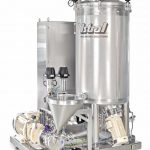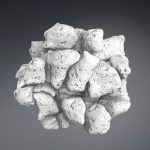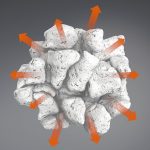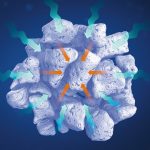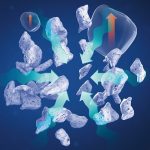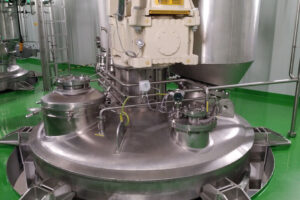Polymers in powder form are used as thickeners, gel forming agents, binders, flocculants and functional additives in a variety of applications from pharmaceuticals to waste-water treatment. Processing polymer powders in liquids is problematic, as these products are highly shear sensitive after developing their polymer structure. They tend to stick and agglomerate as soon as they come into contact with liquids. Moreover, they are very light, fine and often dusty. They can only be mixed into liquids with difficulty and are liable to float on the surface. With the Ystral Conti-TDS, the powder is not added to the liquid surface. Instead, the machine is installed outside the vessel; it recirculates the liquid and inducts and disperses the powder into the liquid stream.
In a fraction of a second
Powders consist of individual particles, which contact each other in the unreacted state. There is, of course, air between these particles that expands under vacuum. The Conti-TDS uses this effect to separate the powder particles before they are mixed into the liquid. The machine creates an extra-powerful vacuum directly in the dispersing zone. The powder is inducted into this zone precisely. The closer the powder comes to the dispersing zone, the higher the vacuum and the larger the distances between individual particles. No air is added – the air which was already present in the powder beforehand simply expands.
The individual powder particles and the liquid come into contact under maximum turbulence in the dispersing zone, where they are fully wetted and colloidally dispersed. No agglomerates are formed. No further dispersion is required. At the moment of wetting the powder is not yet hydrated and the polymer structure not yet formed. This means that the product is not yet shear sensitive. Maximum dispersion is desirable and encouraged at precisely this moment; it is no longer wanted afterwards in a downstream dispersion stage or machine. The shear forces only last for a fraction of a second.
Agglomerates broken up
Even if the powders contain hard and dry agglomerates, they are fully wetted in this way and the agglomerates are not stabilised – as they would be if they were simply injected or stirred in – but broken up. This is due to the fact that agglomerates also contain air internally between the particles. This internal air expands when approaching the dispersing zone, which is under vacuum. The air escapes from the agglomerate without the agglomerate disintegrating. The agglomerate is fully wetted on the outside in the dispersing zone. Wetting takes place under maximum vacuum.
The agglomerate, which is fully surrounded by liquid, then advances together with the liquid and emerges from the zone of maximum vacuum and maximum dispersion into the zone of maximum excess pressure and maximum centrifugal effect. The internal air now contracts similar to an implosion under the excess pressure acting on it and draws in the surrounding liquid to its centre as a result. The agglomerates immediately disintegrate owing to the simultaneous strong dispersion.
The air which was previously contained in the powder, but is now separated from it, coagulates under the centrifugal effect of the rotor into large air bubbles and is transported to the process vessel together with the liquid, where it escapes via the liquid surface.
Economical operation
The process is characterised by particularly gentle, rapid dispersion and maximum wetting of the powder. Manufacturers of paints, cleaning products, cosmetics and adhesives are able to reduce the amount of polymer thickener by 10 to 15 % when using this machine. Users in water and waste-water treatment save up to 15 % of their flocculant this way. More than 25 % of the gelling agent can be dispensed with when manufacturing medical pain relief gels. This proportion has always been destroyed by shear up to now, either in a vacuum process tank with an integrated disperser or in another dispersion machine installed downstream.
However, applications also exist where polymer structures have to be sheared and dispersed exactly on the spot. This is the case, for example, with dish-washing detergents in order to create a silky touch without sticking, with anti-foaming agents to avoid wetting failures or with products that have been adjusted to a high viscosity for transport but must have a reduced viscosity for application. Here, too, the Conti-TDS offers several advantages, as the dispersion is controlled and dosed in combination with improved wetting.
Online search: cpp0218ystral
Hall 6.0, Booth C61





